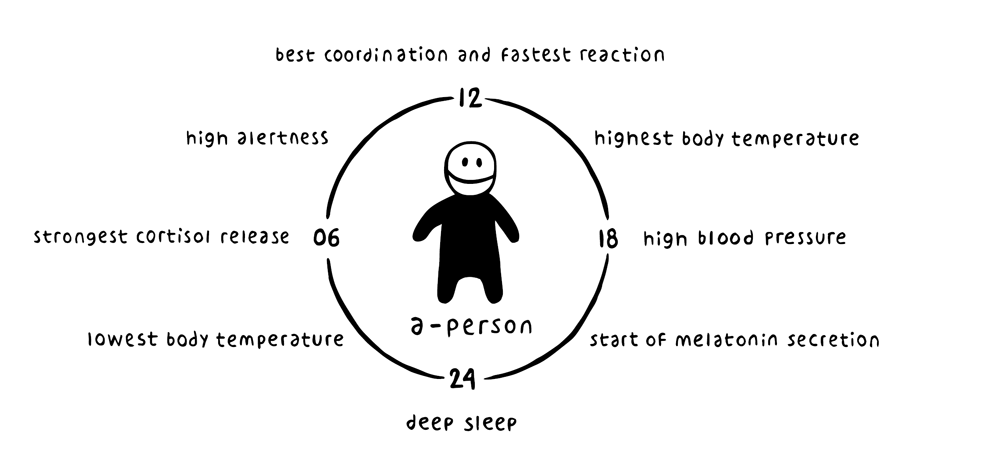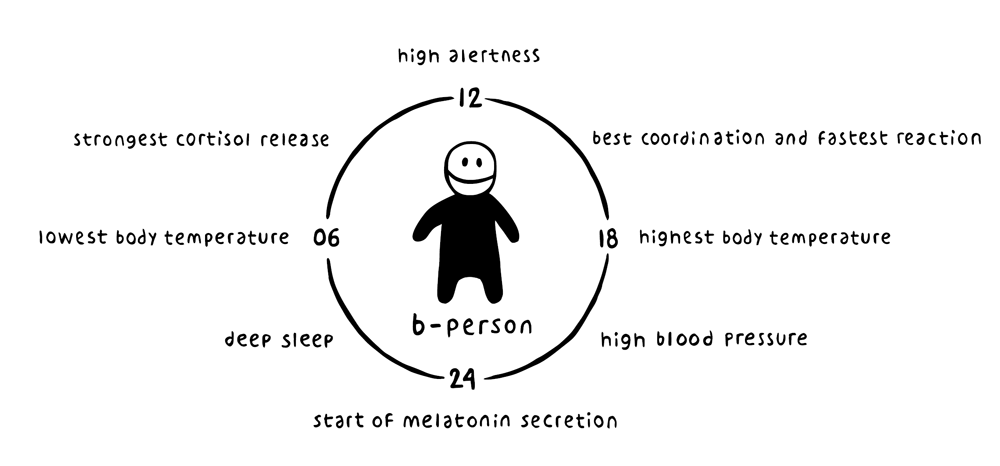
Chronobiology
Chronobiology is the study of circadian clocks. In 2017, three American chronobiologists, Jeffrey C. Hall, Michael Rosbash, and Michael W. Young, received the Nobel Prize in Medicine for their discoveries of the molecular mechanisms that control human circadian rhythms. Our circadian clocks specify when we sleep and when we awaken.
The word chronobiology comes from Greek and means time and biology. You are born with an internal biological clock, a master clock, which sits in the part of the brain called the hypothalamus. The master clock is also called the suprachiasmatic nucleus or SCN – and consists of approximately 20,000 nerve cells. It is the variations in human genes that cause us to sleep and be awake at different times of the day. Your circadian rhythm is therefore not something you choose. Some people fall asleep early and get up early, while others fall asleep later and get up later. You are genetically predisposed to be either morning fresh or evening fresh.
The body is made up of 30 billion cells, divided into organs and tissues. Every single one of these cells contains a biological clock, which is pretty dizzying to think about. All the cells’ clocks are controlled by one master clock, the SCN, which is found in the brain. The SCN is located in the part of the brain called the hypothalamus, which is found at the bottom of the midbrain. Overall, this brain region controls some bodily functions of which we are not normally aware, but that have a huge impact on us and the way we live. Over the course of a day, SCN regulates the rhythm of all the basic processes in our body: when we sleep and wake up, our digestion, body temperature, blood pressure, metabolism, cognitive functions and hormonal balance.

Let’s look at how SCN (the masterclock in our brain) regulates the rhythm of all the basic processes in your body. The drawing illustrates a 24-hour rhythm in a moderate early chronotype (A-person). That is, one who goes to bed at 10 pm and gets up at 6 am (with a need for sleep of 8 hours). The sleep hormone melatonin is secreted when we get tired and if you are a moderately early chronotype it will happen early in the evening. This means that you get tired and go to bed early. The lowest body temperature has the moderate early chronotype around 3 o’clock at night. Human body temperature is lowest when we sleep. When the body temperature is lower, the body does not need as much energy to keep going. The strongest cortisol release is excreted around 6 o’clock in the morning. It is cortisol that enhances our clarity and alertness, and sharpens our senses.

The drawing illustrates a 24-hour rhythm in a moderate late chronotype (B-person). In contrast to the illustration of the circadian rhythm in an A-person (early chronotype), the sleep hormone in the moderate late chronotype is not secreted until around midnight, which is why the late chronotype generally falls asleep after this time. It also appears from the drawing that the moderate late chronotype has the deepest sleep around 3 o’clock, whereas the moderate early chronotype’s deep sleep occurred already at midnight. The drawing here also shows that the strongest cortisol release takes place around 9 o’clock in the morning, which means that the late chronotype only feels awake later in the morning.
Biology is characterized by variation. Some people are over two meters tall, while others are 1.60 meter tall. Some people have small feet, and others big feet. It is the same way with our inner biological clock. Some people have an internal clock that goes fast, while other people have an internal clock that goes slow. Some people fall asleep early and get up early, while others fall asleep later and get up later. In order to adapt to the Earth’s rotation around its own axis, the biological clock has a special synchronization mechanism. The SCN needs signals outside the body to be able to adjust its cycle on a daily basis. Without these synchronization signals, the internal biological clock would gradually deviate — more and more with each passing day — from the day and night rhythm of the surroundings. The most important synchronization signal is daylight. In mammals, light is perceived through special light receptor cells, which are located behind the eye. When sunlight hits the eye, the so-called ganglion cells — via special pathways in the optic nerve — send a message to the SCN. The SCN then causes the small cone gland in the brain to stop the secretion of the sleep hormone melatonin. The contrast between light and darkness is of great importance for the synchronization of our inner clock to the Earth’s rotation around its own axis.
You can test your chronotype at https://chronotype-self-test.info/ or https://www.bodyclock.health/
